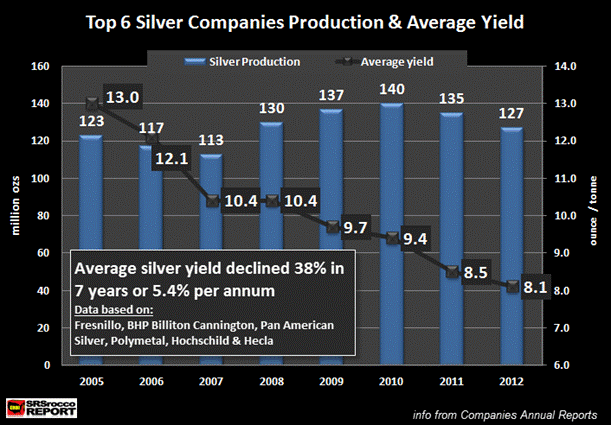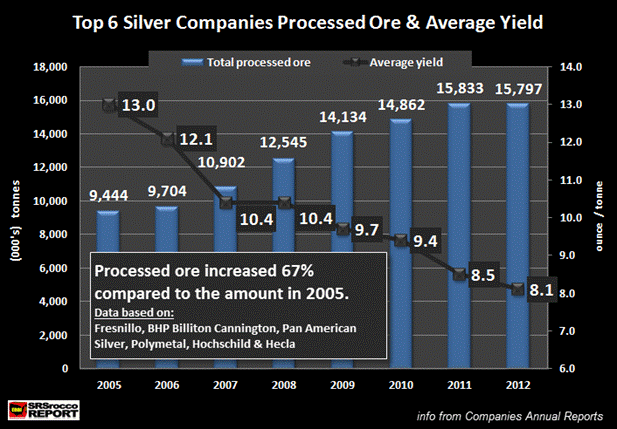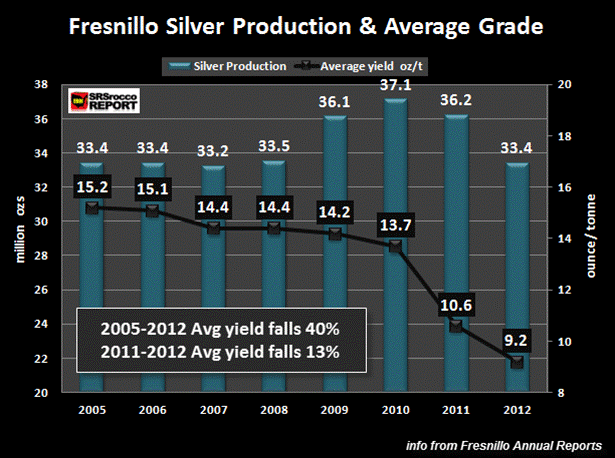Silver Price to Rise as Top Miner's High Grade Production Evaporates
Commodities / Gold and Silver 2013 Jun 19, 2013 - 06:27 AM GMTBy: Steve_St_Angelo
 One of the most insidious problems taking place in the gold and silver mining industry is the decline in falling yields. Not many realize, when yields decline, production evaporates and disappears. To offset the decline in metal yields, the mining companies have to add new mines and or increase the amount of processed ore.
One of the most insidious problems taking place in the gold and silver mining industry is the decline in falling yields. Not many realize, when yields decline, production evaporates and disappears. To offset the decline in metal yields, the mining companies have to add new mines and or increase the amount of processed ore.
If we take a look at the top 6 silver producers, we can see that the average yield declined 38% since 2005, from 13.0 oz/t (ounce/tonne) to 8.1 oz/t in 2012:

The companies and individual primary silver mine included in the graph above were, Fresnillo, BHP Billiton Cannington, Pan American Silver, Polymetal, Hochshild & Hecla. Furthermore, I only included primary silver mine production from these companies.
For example, both Fresnillo and Polymetal had higher annual silver production figures than is shown in the graph above. This by-product silver came from their primary gold mines and was excluded from the calculations as it would have significantly lowered the average yield.
This next chart shows the inverse relationship between falling yields and increased processed ore:

In 2005, these companies processed 9.4 million tonnes of ore to produce 123 million ounces of silver. However, by 2012 a total of 15.8 million tonnes of ore was processed, an increase of 67%, to supply 127 million oz of silver.
Pan American's Dolores silver & gold open-pit mine was not included in the 2012 calculations due to its extremely low average ore grade of 42 g/t (grams/tonne). Even though the Dolores mine added 2.6 million oz to Pan American's total, it would have severely impacted the group's 2012 annual yield by knocking it down from 8.1 oz/t to 6.4 oz/t.
Declining Silver Yields = Evaporated Production
If we take the top 6 silver production in 2005 at 123 million oz and figure a seven-year 38% decline in yield, we would have the following:
123 million oz (X) -38% yield = 47 million oz loss of production
So, if no new production was added by these 6 mining companies overall supply would have declined to 76 million in 2012. To be able to increase production on top of declining yields, the silver miners have to either add new mines or ramp up their milling and processing of ore.
A perfect example of this took place at Fresnillo. Here we can see that overall production at Fresnillo remained the same in 2012 as it was in 2005:

How was Fresnillo able to keep its production at 33.4 million oz as its average yield declined from 15.2 oz/t in 2005 down to 9.2 oz/t in 2012? This 40% decline in yield caused a huge reduction of 13.3 million oz in this seven-year time period.
To offset this large decline in yield, the company ramped up its milling capacity 26% at its Fresnillo mine and added production from its new Saucito mine. In 2012, the Fresnillo mine accounted for 26.4 million oz of production while Saucito made up the difference by adding 7 million oz to the total.
Again, the figures in the chart above only came from Fresnillo's two primary silver mines... Fresnillo and Saucito. Fresnillo accounted for all the production until 2011 when Saucito ramped up production.
This is the big problem companies face as silver yields decline. In the case above, Fresnillo PLC had to ramp up production at Fresnillo and had to bring on a new mine (Saucito) just to keep production the same as it was seven years ago.
Now we can see how costs rise as yields decline. For instance, think of all the capital it took to bring Saucito from the exploration stage to commercial mine production. Furthermore, the company had 875 contractors working at its Saucito mine in 2012 including all the additional mining equipment, materials and energy costs.
The Cost to Produce Silver will Rise as Yields Continue to Decline
The impact of falling yields shown in the Fresnillo example above is taking place in the whole mining industry. Pan American Silver was producing silver at 7.4 oz/t in 2005, but by 2012 this had fallen to 5.1 oz/t (this is excluding the Dolores open-pit mine which would drop the average yield down to 2.9 oz/t). Furthermore, Hochschild's average silver yield declined from 12.4 oz/t in 2005 to only 6.7 oz/t in 2012. I could go on and on.
What we are witnessing here is the evaporation of high-grade silver production only to be replaced by a much more expensive low yielding supply. This will only become more difficult each passing year. As costs to mine silver continue to rise in the future, so will the price of silver.
Lastly, energy is the overwhelming factor contributing to the increased costs of mining silver as yields decline. Thus, silver will become one of the best stores of value in the future because it functions as an excellent store of trade-able energy value.
At the SRSrocco Report, we will explore how energy will impact the mining industry in the future. Falling ore grades and decreasing yields are only part of the problem. As net oil exports continue to decline, energy prices will rise putting more pressure on the mining industry. Thus, rising energy costs will guarantee rising prices of gold and silver.© 2013 Copyright Steve St .Angelo - All Rights Reserved Disclaimer: The above is a matter of opinion provided for general information purposes only and is not intended as investment advice. Information and analysis above are derived from sources and utilising methods believed to be reliable, but we cannot accept responsibility for any losses you may incur as a result of this analysis. Individuals should consult with their personal financial advisors.
© 2005-2022 http://www.MarketOracle.co.uk - The Market Oracle is a FREE Daily Financial Markets Analysis & Forecasting online publication.



